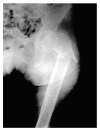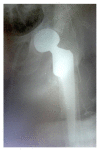An Unexpected Complication of Hip Arthroplasty: Knee Dislocation
- PMID: 26347838
- PMCID: PMC4546968
- DOI: 10.1155/2015/294187
An Unexpected Complication of Hip Arthroplasty: Knee Dislocation
Abstract
An increasing number of patients with hip fracture have been seen with osteoporosis associated with osteoarthritis. Although knee dislocation is related to high-energy trauma, low-grade injuries can also lead to knee dislocation which is defined as "ultra-low velocity dislocation." The case reported here is of an 82-year-old patient who presented with a left intertrochanteric hip fracture. Partial arthroplasty was planned because of osteoporosis. In the course of surgery, degenerative arthritic knee was dislocated during the hip reduction maneuver with the application of long traction. The neurovascular examination was intact, but the knee was grossly unstable and was dislocated even in a brace; thus a hinged knee prosthesis was applied nine days after surgery. The patient was mobilized with crutches after the knee prosthesis but exercise tolerance was diminished. In conclusion, it should be emphasized that overtraction must be avoided during the hip reduction maneuver in patients with advanced osteoarthritic knee.
Figures






Similar articles
-
Failure of Polyethelene Insert Locking Mechanism after a Posterior Stabilised Total Knee Arthroplasty- A Case Report.J Orthop Case Rep. 2016 Jul-Aug;6(3):35-37. doi: 10.13107/jocr.2250-0685.492. J Orthop Case Rep. 2016. PMID: 28116264 Free PMC article.
-
Dislocation of Rotating Hinged Knee Prostheses in a Patient With Extensor Mechanism Dysfunction.Cureus. 2022 Apr 12;14(4):e24091. doi: 10.7759/cureus.24091. eCollection 2022 Apr. Cureus. 2022. PMID: 35573576 Free PMC article.
-
Total Knee Arthroplasty in a Patient with Secondary Osteoarthritis Knee with Instability due to Neglected Chronic Anterior Dislocation: A Case Report.J Orthop Case Rep. 2024 Jan;14(1):58-62. doi: 10.13107/jocr.2024.v14.i01.4148. J Orthop Case Rep. 2024. PMID: 38292088 Free PMC article.
-
Total knee arthroplasty in patients with prior ipsilateral hip arthrodesis.Eur J Orthop Surg Traumatol. 2018 Apr;28(3):521-524. doi: 10.1007/s00590-017-2070-1. Epub 2017 Oct 27. Eur J Orthop Surg Traumatol. 2018. PMID: 29080048 Review.
-
Total Hip and Knee arthroplasty in a patient with osteopetrosis: a case report and review of the literature.BMC Musculoskelet Disord. 2015 Sep 21;16:259. doi: 10.1186/s12891-015-0716-x. BMC Musculoskelet Disord. 2015. PMID: 26391128 Free PMC article. Review.
References
LinkOut - more resources
Full Text Sources
Other Literature Sources

